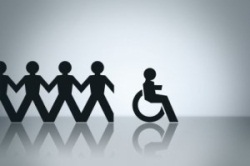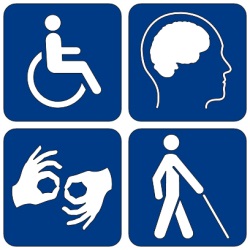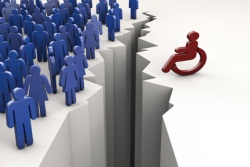For the sake of viewer convenience, the content is shown below in the alternative language. You may click the link to switch the active language.
Multiple Impairments: Awareness

It is common to find that what causes a single type of impairment also causes others. This is particularly true where disease or trauma is severe, or in the case of impairments caused by aging.
Deaf-blindness is one commonly identified combination. Most of these individuals are neither profoundly deaf nor legally blind, but are both visual and hearing impaired to the extent that strategies for deafness or blindness alone won’t work.

People with developmental disabilities may have a combination of mental and physical impairments that result in substantial functional limitations in three or more areas of major life activity.
For example:
- Diabetes, which can cause blindness, also often causes loss of sensation in the fingers. This makes braille or raised lettering impossible to read.
- Cerebral palsy is often accompanied by visual impairments, by hearing and language disorders, or by cognitive impairments.
For more information on any of the disability types listed in this section see:
Click on the disability type below for more details:
Visual impairment represents a continuum, from people with very poor vision, to people who can see light but no shapes, to people who have no perception of light at all. However, for general discussion it is useful to think of this population as representing two broad groups: those with low vision and those who are legally blind.
Low vision includes problems (after correction) such as dimness of vision, haziness, film over the eye, foggy vision, extreme near- or farsightedness, distortion of vision, spots before the eyes, color distortions, visual field defects, tunnel vision, no peripheral vision, abnormal sensitivity to light or glare, and night blindness.
Those who are legally blind may still retain some perception of shape and contrast or of light vs. dark (the ability to locate a light source), or they may be totally blind (having no awareness of environmental light).
Impact on Study:
Effect:
- Student will not be able to work efficiently (at least) from visual displays and other visual output during lectures and for example seminar presentations.
- Student’s ability to read will be limited. Written operating instructions and other documentation may be unusable, and there can be difficulties in manipulation.
- Carrying out field or laboratory work may be virtually impossible and potentially dangerous.
How to Help:
- Seek alternate assessment in place of field or lab work.
- Many people with visual impairments still have some visual capability, so many of them can read with the assistance of magnifiers, bright lighting and glare reducers. Many such people with low vision are helped immensely by use of larger lettering, sans-serif typefaces, and high contrast coloring.
- Those with color blindness may have difficulty in those instances when information is color coded or where color pairs are chosen which result in poor ‘figure-ground’ contrast. For example, a student might have difficulty perceiving the words on paper from their background.
- Key coping strategies for people with more severe visual impairments include the use of braille and large raised lettering. Note, however, that braille is preferred by only 10% of blind people (normally those blind from early in life). Raised lettering must be large and is therefore better for indicating simple labels than for extensive text.
Additional Information:
- https://actionforblindpeople.org.uk
- Everyday living for the blind: http://www.rnib.org.uk
Hearing impairment means any degree and type of auditory disorder, while deafness means an extreme inability to discriminate conversational speech through the ear. Deaf people are those who cannot use their hearing for communication. People with a lesser degree of hearing impairment are called hard of hearing. Usually, a person is considered deaf when even amplified speech cannot be understood.
Impact on Study:
Cause – Difficulty in receiving auditory information.
Effect – Unable to properly participate in lectures or presentations, if at all.
How to Help:
- Present auditory information in visual and/or tactile form. Increasing the volume range and lowering the frequency of products with high pitched auditory output would be helpful to some less severely impaired individuals.
- Familiar coping strategies for hearing impaired people include the use of hearing aids, sign language, lip-reading and TDDs (telecommunication devices for the deaf).
Additional Information:

Problems faced by individuals with physical impairments include poor muscle control, weakness and fatigue, difficulty walking, talking, seeing, speaking, sensing or grasping (due to pain or weakness), difficulty reaching things, and difficulty doing complex or compound manipulations (push and turn). Individuals with spinal cord injuries may be unable to use their limbs and may use “mouthsticks” for most manipulations. Twisting motions may be difficult or impossible for people with many types of physical disabilities. The listed symptoms described are found in, for example:
- Cerebral palsy
- Spinal cord injury
- Arthritis
- Multiple sclerosis
- Muscular dystrophy
Neuromuscular impairments include:
- Paralysis (total lack of muscular control in part or most of the body)
- Weakness (paresis; lack of muscle strength, nerve enervation, or pain)
- Interference with control, via spasticity (where muscles are tense and contracted), ataxia (problems in accuracy of motor programming and coordination), and athetosis (extra, involuntary, uncontrolled and purposeless motion)
For more information on the types of disabilities listed above and more, see: http://trace.wisc.edu/docs/population/populat.htm#physical
Impact on Study:
Effect:
- Student may be unable to access lecture halls, library facilities etc. or to carry out basic every-day actions and perform required tasks such as writing, typing, field or lab work.
How to Help:
Commonly used assistive devices include:
- Mobility aids (e.g., crutches, wheelchairs), manipulation aids (e.g., prosthetics, orthotics, reachers)
- Communication aids (e.g., single switch-based artificial voice)
- Computer/device interface aids (e.g., eye-gaze-operated keyboard)
- Provide extra space in the lecture halls, for example, allocated space for wheel chair users
Additional Information:
The type of cognitive impairment can vary widely, from severe retardation to inability to remember, to the absence or impairment of specific cognitive functions (most particularly, language). Therefore, the types of functional limitations which can result also vary widely.
Cognitive impairments may be categorized as:
- Memory problems include difficulty getting information from both short and long-term, and remote memory. This includes difficulty recognizing and retrieving information
- Perception problems include difficulty taking in, attending to, and discriminating sensory information
- Difficulties in problem-solving include recognizing the problem, identifying, choosing and implementing solutions, and evaluation of outcome
- Conceptual difficulties can include problems in sequencing, generalizing previously learned information, categorizing, cause and effect, abstract concepts, comprehension and skill development
- Language impairments can cause difficulty in comprehension and/or expression of written and/or spoken language
Impact on Study:
Effect:
- Students may be very slow to produce work and may struggle to reach deadlines
- May often misinterpret instructions from tutor
How to Help:
There are very few assistive devices for people with cognitive impairments:
- Simple cueing aids or memory aids
- As a rule, these individuals benefit from use of simple displays, use of patterns, simple, and obvious sequences
- Alternate assessment to timed examination may be needed
A number of injuries or conditions can result in seizure disorders. Epilepsy is a chronic neurological disorder. Seizures can vary from momentary loss of attention to grand mal seizures which result in the severe loss of motor control and awareness. Seizures can be triggered in people with photosensitive epilepsy by rapidly flashing lights.
The main symptoms of epilepsy are repeated seizures. Most people have a consistent pattern of symptoms.
Doctors classify seizures by how much of the brain is affected. There are:
- partial (or focal) seizures (both simple and complex) – where only a small part of the brain is affected
- generalised seizures – where most or all of the brain is affected
Symptoms of a simple partial seizure (in which one remains fully conscious throughout) can include:
- a “rising” feeling in your stomach, such as that when on a fairground ride
- an intense feeling that events have happened before (déjà vu)
- experiencing an unusual smell or taste
- a tingling sensation, or “pins and needles”, in your arms and legs
- a sudden intense feeling of fear or joy
- stiffness or twitching in part of the body, such as an arm or hand
These seizures are sometimes known as “warnings” because they can be a sign that another type of seizure is on its way.
Complex partial seizures are when one loses their sense of awareness and can’t remember what happened after the seizure has passed.
The symptoms of a complex partial seizure normally involve more regular behaviour such as:
- smacking your lips
- rubbing your hands
- making random noises
- moving your arms around
- picking at clothes
- fiddling with objects
- adopting an unusual posture
- chewing or swallowing
For a list of the types of generalised seizures (where most or all the brain is affected) consisting vastly of the symptoms listed above, see:
http://www.nhs.uk/Conditions/Epilepsy/Pages/Symptoms.aspx
Impact on Study:
Effect:
- May cause great disturbances in lectures and seminars etc.
- May be potentially life-threatening if in the lab or near potential physical danger.
How to Help:
- Avoid the use of flash lighting, or mention it as a warning
- Protect subject from injury by removing any dangerous or potentially harmful objects nearby, and cushioning their head with your hands or soft material
- Do not restrain them or attempt to move them (unless they are in immediate danger) and don’t put anything in their mouth
- Stay calm, and stay with them until they regain consciousness
- When the convulsions have stopped, put them into the recovery position until they have recovered
When to call an ambulance:
It will not usually be necessary to call an ambulance after a seizure. However, you should call 999 if:
- the seizure has not stopped after five minutes
- the person has more than one seizure without recovering in between
- the person is injured, has breathing problems, or needs emergency medical attention for any other reason
- the person’s behaviour after a seizure is unsafe
For more information:


